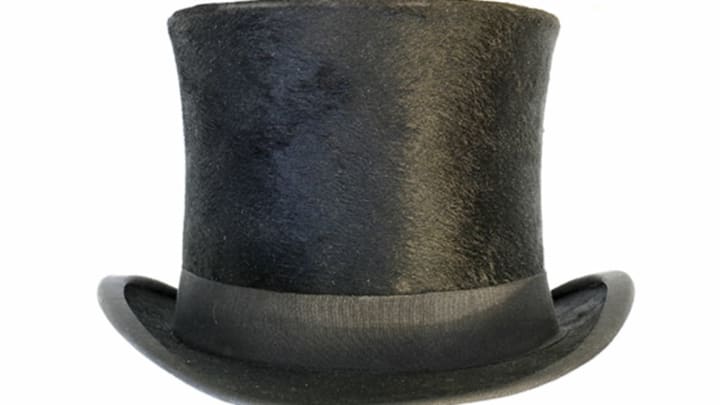The clothes may make the man, but sometimes it's what the clothes make the man do that makes the story. Throughout history there have been more than a few instances of an article of clothing actually inciting a riot. Here are some examples.
1. Straw Hats
Over several nights in September 1922, gangs of hundreds of young thugs terrorized Manhattan, destroying any "unseasonable straw hat" they found. According to contemporary New York Times reports, these fashion vigilantes were armed with sticks, some with nails at the ends, and forced men in straw hats to run "gauntlets" of fists and boots. The streets were littered with broken and trampled straw hats and the remains of straw hat bonfires, the police were called in to disperse the unruly hat-haters, and hat stores were forced to stay open late to accommodate the newly hatless.
According to the Times, the hat-smashers were gangs of mostly young boys who took very seriously the September 15th end of straw hat season.
While Magistrate Peter A. Hatting (no, really) upheld the inalienable right of a man to wear a straw hat "in a January snowstorm if he wishes," the hat-smashers disagreed, choosing instead to attack any straw-hatted person and destroy their hat for them. Dozens were arrested and fined over the course of the riots and people, including several off-duty and presumably straw hat-wearing police officers, were injured.
Oddly, this same scenario had unfolded only eight years earlier, in Bridgeton, New Jersey, when the official end of hat season was September 1. The hat-snatching started as a fraternity prank, but quickly turned violent as people got rowdy and hat-wearers began to fight back. Eventually, the police and fire department had to be called in to subdue the rioters and a good number of them were hauled into court.
2. A Soccer Jersey

3. Trouser Skirts
Paris takes its fashion very, very seriously. So seriously, in fact, that wearing the wrong thing has actually caused a riot.
In 1911, two rival Parisian couture houses launched their "trouser skirts," an innovation in fashion that trod the very fixed line between the genders and seemed to promise greater flexibility for women in general. There were two different versions of the trouser skirt: One was a sort of baggy pant with a very low hanging crotch, described as "a sack with holes made for the legs to go through," not unlike the fashions on high streets today, and the other a pair of the same kind of pants topped with an over-skirt, again, not unlike high street fashions of today. Both versions were launched by models at the opening day of racing season to general revulsion and disgust, but thankfully, no violence.
It wasn't until the ladies attempted to promenade their future fashions on the boulevards that the fisticuffs started—at the Place de l'Opera, the poor models were attacked by a jeering mob of fashion Philistines, who pulled their hair, trampled their hats, and reduced them to tears. A squad of police officers on bicycles were dispatched to rescue the girls and escort them to safety.
4. Sheath Skirts
Riots in Paris we get—people in Paris love any excuse, good or not, to riot—but at anything-goes Coney Island? Bizarre, but true.
In 1908, two women clad in daring sheath, or Directoire, skirts—very tight, though long, skirts—were forced to take refuge in an automobile from an angry, pressing crowd until they were rescued by police. According to a contemporary report from the New York Times, the two women, attired in "steel gray" and "livid purple" respectively, in front of a restaurant with their dates. The couples were attempting to go to dinner when a crowd began to form around the women, "craning their necks and making remarks that did not please the wearers of the skirts."
The women were forced back into the car by the several hundred men and women crowding around them; the local policeman had to call in reserves in order to disperse the mob.
5. Any Clothes at All
In March 2009, a tourist was blamed for a "mini-riot" at a swinging sex party at an Australian nudist camp after he refused to remove his clothing. Really.
According to the owner of the White Cockatoo Resort in North Queensland, where the fracas occurred, the fight started when four female guests were confronted by one clothed man. The women complained that if he was going to see them naked, they ought to get to see him naked as well. The owner asked the man to remove his clothes, the man got angry, some "argy-bargy" (whatever that means) followed, the man was kicked off the premises, and the police were called.
6. Not a Top Hat
According to the Hatter's Gazette, in 1797, a London haberdasher named John Hetherington was hauled into court on charges of breaching the King's peace, found guilty, and ordered to pay a £500 fine. His crime? Wearing a silk top hat, or, as it was supposedly described in court, "appearing on the public highway wearing upon his head a tall structure having a shining lustre and calculated to frighten timid people." It's said that people booed, dogs barked, women fainted, and a small boy suffered a broken arm after a crowd formed around the hapless Mr. Hetherington.
Unfortunately, this popular story—one we've mistakenly published previously—is likely untrue. There is no contemporary evidence to back this account up, and there are no records in Old Bailey, the central criminal court of England, to suggest it ever happened. Furthermore, tall men's hats were already cropping up across Europe at the time of Hetherington's purported faux pas. The heightened headgear might have attracted awkward glances, but incite a riot? Unlikely.
This story originally appeared in 2009.
